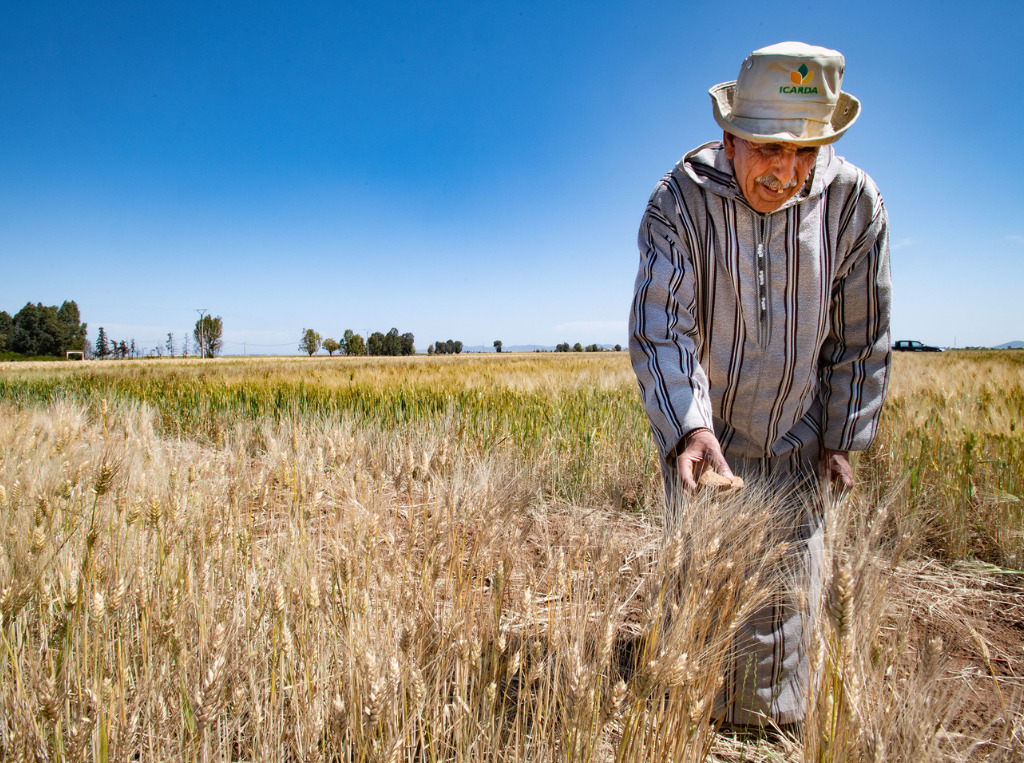Small-Scale Farmers Receive 0.8% of Climate Finance Despite Providing a Third of Our Food Supply
6 Mins Read
Amid climate change and food security challenges, small-scale farmers and supply chain actors receive less than 1% of global climate funding, despite being responsible for 35% of the world’s food supply.
In fact, these numbers actually dropped by 44% in 2019-20 compared to 2017-18 – though the sources, objectives and geographic distribution of the finance were largely similar.
In August, research non-profit Climate Policy Initiative released a report revealing the gaping gap in climate finance when it came to agrifood systems. Despite food and agriculture making up a third of all global greenhouse gas emissions, this sector only received 4.3% of all climate funding in 2019 ($28.5B).
Now, a new report by its agri-finance programme the ClimateShot Investor Coalition (CLIC), has revealed that this chasm is even starker when it comes to smallholders and the agricultural micro-, small-, and medium-sized enterprises (MSMEs) serving them – while this group supplies 35% of the world’s food and faces climate-related food insecurity, it only receives 0.8% ($5.53B) of all climate investment globally ($660.2B).
Despite a rise in overall climate funding, the data – evaluated for 2019-20 – revealed that this figure for small-scale agrifood systems saw a 44% drop over 2017-18 ($9.85B), when it accounted for 1.7% of total climate finance. Small farmers and MSMEs also only make up 19% of the total agrifood funding.
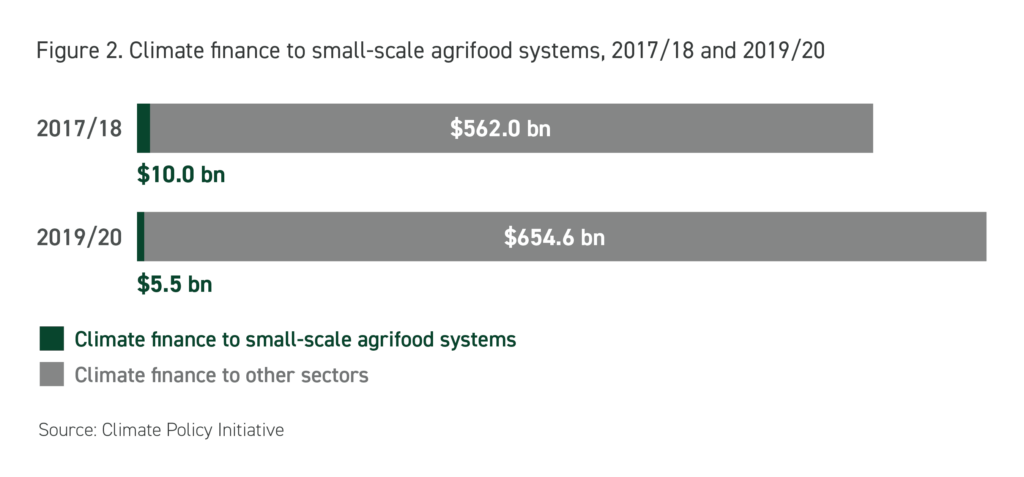
Small-scale farms make up 84% of the world’s 570 million farms and control 12% of total agricultural land. In South Asia and sub-Saharan Africa, MSMEs are responsible for 65% of all food produced. Globally, small-scale agriculture and land-use change due to agriculture contribute to about 5% of global greenhouse gas emissions. Yet these are the people most heavily affected by climate change events like extreme heat, droughts and floods, with crop failures and uncertain harvests becoming increasingly common.
“Despite their critical position in food production, emissions, and climate vulnerability, small-scale farmers and agri-MSMEs receive a meagre share of climate finance,” says the report. For smallholder farms, the unmet general financing needs are calculated to be $170B annually, while for agri-SMEs, that’s $106B – a far cry from what they receive right now.
Financial sources and climate objectives
The distribution of climate finance from different sources highlights the need (and opportunity) for private funding. Almost all of the $5.53B received by small-scale agriculture comes from public entities, which make up 96% of the share ($5.3B). Nearly half of this ($2.7B) is in the form of grants, while 39% ($2.2B) is given as concessional debt.
Despite equity accounting for 3% of agrifood finance as a whole, it only made up 0.3% for small producers. “Given their potential for risk sharing and fostering long-term commitments, there is an opportunity for increased equity finance in small-scale agrifood systems,” the report’s authors write.
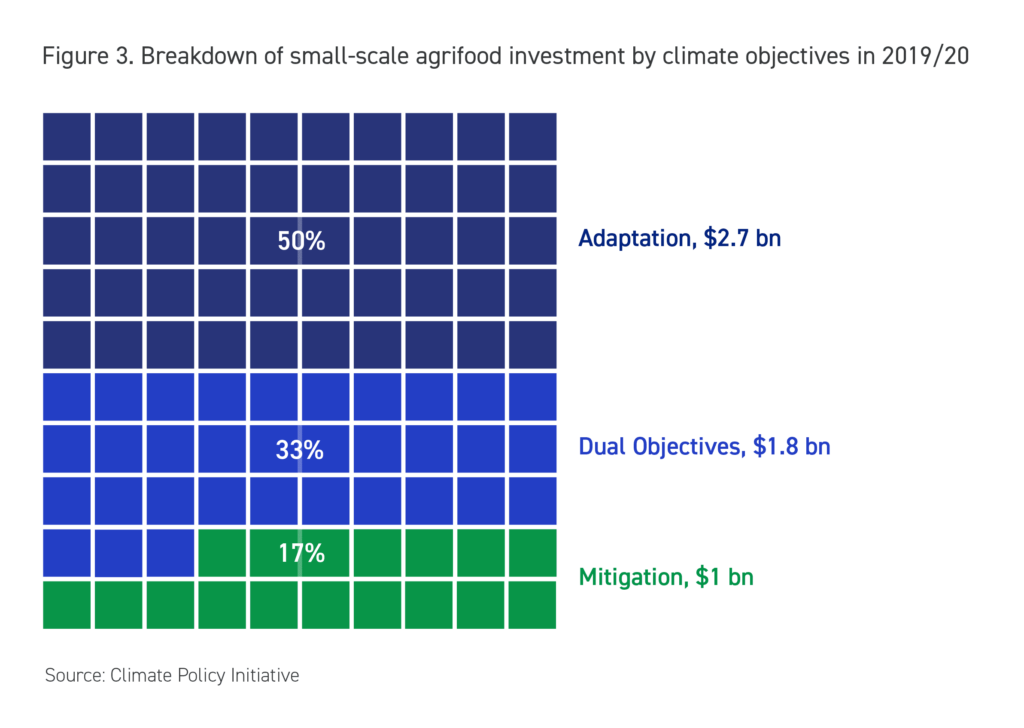
In terms of the climate objectives targeted by these investments, the two main kinds are adaptation and mitigation. The distribution was similar to 2017-18: 50% of finance went to adaptation ($2.7B), 17% to mitigation ($1B), and 33% to dual climate objectives ($1.8B). Notably, 98% of the adaptation funding tracked by CLIC went to non-OECD countries, which aligns with the climate vulnerabilities faced by small-scale producers in low- and low-to-middle-income nations.
Meanwhile, 96% of dual-objective financing came from the public sector – notably governments, which provided $1.3B chiefly through grant funding. But without China’s Conversion of Cropland to Forest Program (CCFP) – worth $1B – this objective would only amount to $800M or 18% of the total. And as mentioned above, mitigation is the least funded objective.
“Such statistics underline the magnitude of the finance gap and indicate opportunities to enhance mitigation and dual climate benefits efforts,” the report states. “Nonetheless, small-scale actors’ high climate vulnerability makes it vital for mitigation interventions to integrate adaptation and resilience measures, in line with just transition principles.”
Geographic distribution
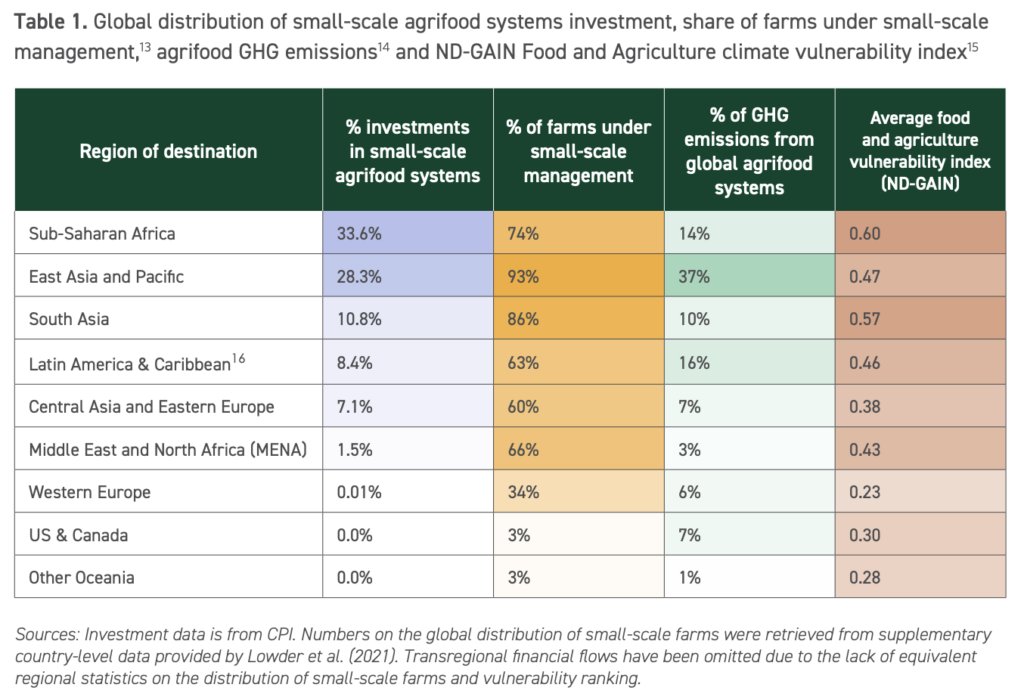
Sub-Saharan Africa, East Asia and the Pacific, and South Asia – which are home to 95% of the world’s smallholder farms – received 73% of the total small-scale climate funding in 2019-20, with the former earning the largest share at 34% ($1.86B), followed by East Asia and the Pacific (28%) – though that’s thanks in large part to the CCFP funds, without which the region would be fourth on the list, despite recording the highest agrifood GHG emissions.
South Asia is “considerably underserved”, amounting to only 11% of small-scale agrifood climate funds, even though it has the second-most climate-vulnerable agrifood systems globally. The Middle East and North Africa, meanwhile, received only 1.5% of the share, despite facing notable climate vulnerability.
A separate report by AgFunder – focused on Asia-Pacific – last month revealed that when it comes to agrifood tech funding in the region, upstream startups (those supporting farm-level efforts) overtook downstream ones (covering tech removed from production level) for the first time last year.
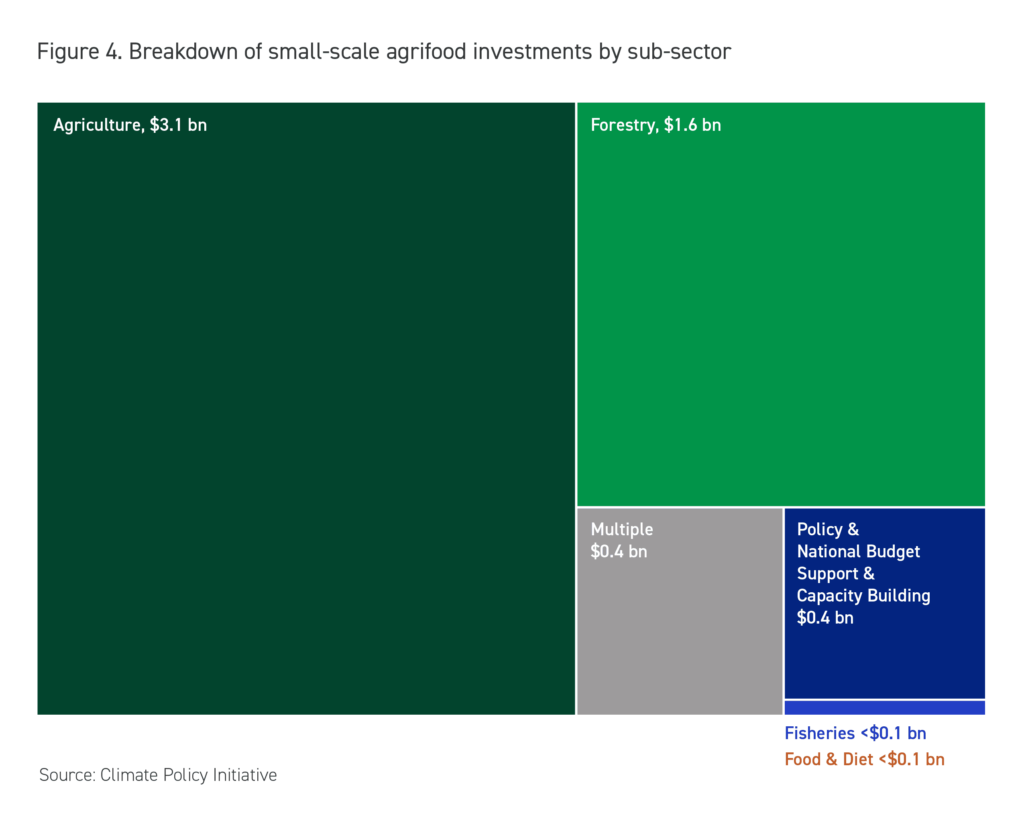
In terms of sub-sector distribution, the CLIC report revealed that the agricultural sector received 57% of all small-scale agrifood funding in 2019-20, followed by forestry (29%). Meanwhile, fisheries received only 0.5% of the financing, while the food waste/loss and low-carbon diet segment had less than 0.1%. “Given that 14% of global food production is lost between harvest and market, this sector is critically underserved,” says the report.
Repurposing subsidies and increasing private finance are key
Agricultural systems are being heavily hit by the climate crisis, with lesser land and water availability combined with extreme weather events leading to crop failures and food shortages. Food staples like tomatoes, potatoes, maize, limes, oranges and even meat and cheese are experiencing low harvests or reduced outputs.
Despite that, a significant amount of the $670B in public subsidies for agriculture and fisheries is “distorted”, with 61% supporting farmers’ planning, harvesting and input decisions in ways that can be detrimental to the environment and economy. “Public agricultural support policies are currently misaligned with a healthy, sustainable, equitable and efficient food systems transformation,” writes the report.
“It is deeply troubling that climate finance to those supporting the bulk of the world’s agricultural value chains has fallen,” said co-author Daniela Chiriac. “Too little is being done to ensure a just climate transition for agrifood systems and to protect the world’s food supplies.”
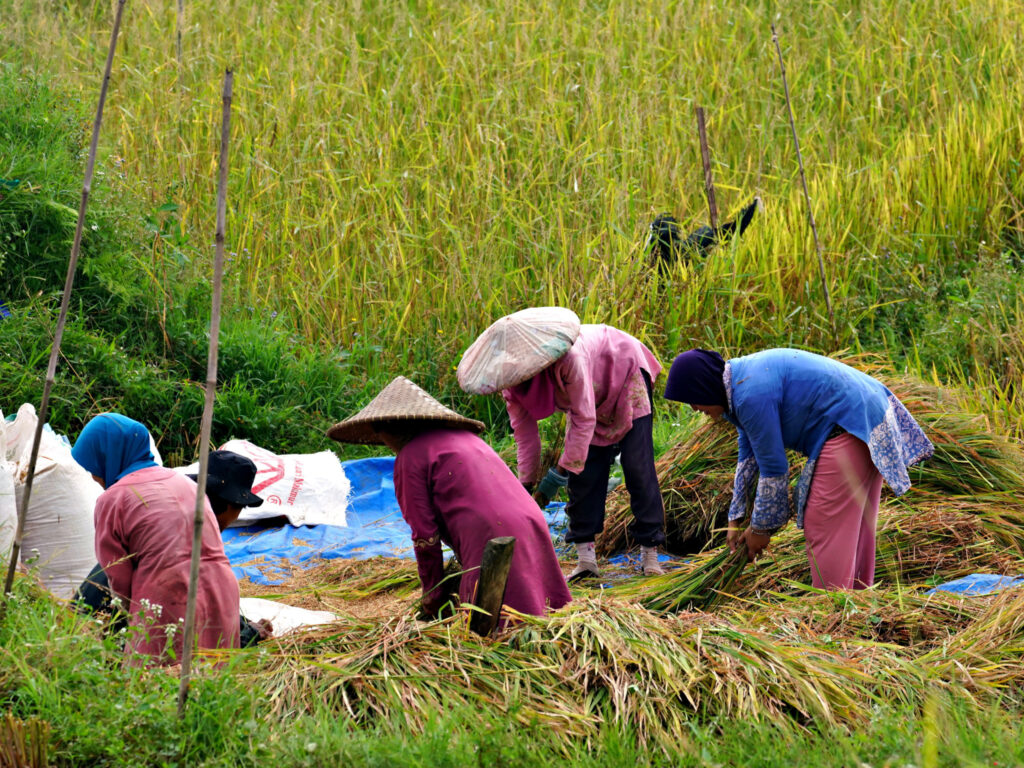
Mike Reddaway, a senior advisor at the UK’s FCDO agrifood research team, added: “We are currently not producing enough food to meet the nutritional needs of millions of people, but demand for food is only growing. If we want to meet the joint challenges of food security and climate change, we need a major increase in the amount of climate finance supporting smallholder farmers.”
The report recommends an equitable repurposing of agricultural subsidies for climate-relevant interventions, investment in scope 3 emissions reductions and regenerative agriculture, greater transparency in the disclosure of climate finance flows across sectors, designing methodologies and collecting granular data to estimate smallholders’ funding needs, and an increase in concessional finance to catalyse private investment, and a progressive rise in climate investment in small-scale agriculture to enable long-term resource planning.
“At a time when much-needed global climate finance is growing across other sectors, we need to be building the same momentum for agriculture and food systems too,” said CPI global managing director Barbara Buchner. “All stakeholders – from governments and finance institutions through to corporations – must combine efforts to increase climate funding to small-scale farmers and agribusinesses that help produce the world’s food.”

